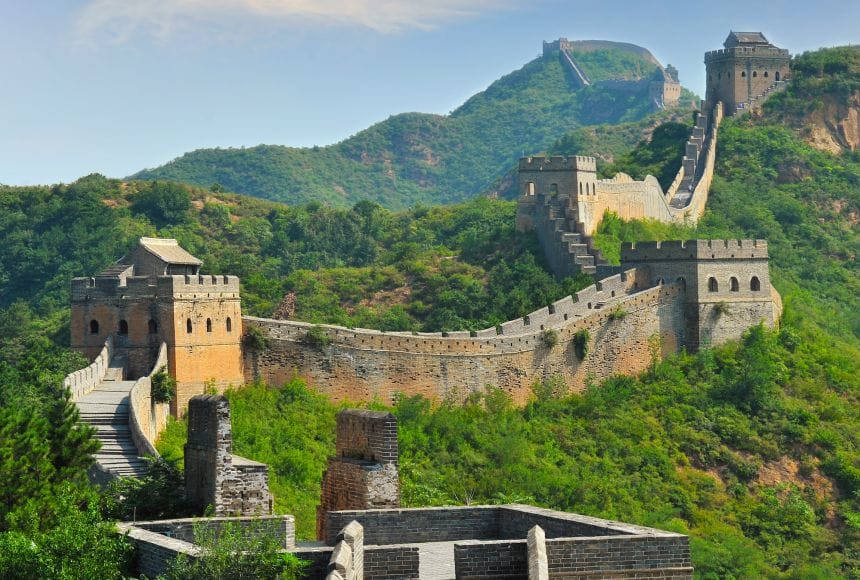Step inside the captivating world of the Great Wall of China, a colossal architectural enigma that has stood for centuries. Imagine this magnificent structure, snaking its way through rugged mountains and valleys, a testament to the ingenuity and resilience of ancient Chinese civilizations. Together, we’ll embark on an exploration of the compelling reasons behind its construction, unraveling the secrets of this historical marvel that has forever shaped China’s destiny.
Why Was the Great Wall of China Built?
The Great Wall of China, a structure so vast it’s visible from space, wasn’t erected on a whim. This architectural marvel, snaking across mountains and deserts, served as a powerful symbol of China’s strength and a testament to its tumultuous past. While its imposing presence aimed to deter invaders, its purpose extended far beyond simply keeping people out.
For centuries, China has been a hub of culture and innovation, making it an attractive target for invaders, particularly nomadic tribes like the Mongols. These fierce warriors posed a constant threat to China’s stability, prompting the need for a formidable defense. The Great Wall, it was hoped, would be that defense, a barrier so imposing it would stop invaders in their tracks.
Yet, the Great Wall was more than a “Keep Out” sign. It also served as a catalyst for trade, facilitating the flow of goods and ideas along the legendary Silk Road. This ancient trade route, connecting East and West, thrived under the Wall’s protection, boosting China’s economy and fostering cultural exchange with the wider world.
The construction itself, spanning centuries and dynasties, was a monumental undertaking. Imagine the stories those walls could tell. It required a massive workforce – prisoners, soldiers, peasants, all contributing to this shared endeavor. This colossal project helped unite different regions of China, bringing people together under a common goal and forging a sense of shared identity.
However, as history often shows, even the most ambitious endeavors can have unintended consequences. The Mongols, renowned for their military prowess, eventually found ways to breach the Wall, proving that no barrier is entirely impenetrable.
Despite this, the Great Wall of China continues to captivate the imagination as a powerful symbol of human ingenuity, resilience, and the enduring legacy of a civilization determined to protect its borders.
For those of you who are passionate about History, check out the latest teaching methods and exciting simulations in our online platform.
Was the Great Wall of China built to keep Mongols out?
The question of whether the Great Wall of China was explicitly constructed to thwart the Mongols is a complex one. The historical context suggests a more nuanced answer. Long before the rise of the Mongols, the Chinese had already begun erecting walls and fortifications along their northern borders.
As early as the 3rd century BC, Qin Shi Huang, the emperor who unified China, connected existing walls to create an early iteration of the Great Wall. His primary objective was to repel the nomadic tribes that frequently raided Chinese settlements.
Centuries later, the Jin Dynasty, facing the burgeoning Mongol Empire under Genghis Khan in the 12th century AD, reinforced and expanded the existing wall. They envisioned it as a bulwark against the formidable Mongol war machine.
However, the Mongols, known for their military prowess and strategic brilliance, proved adept at circumventing even the most imposing barriers. They resorted to bribery, exploiting weaknesses in the defenses, and even bypassing sections altogether.
While the Jin Dynasty’s efforts to fortify the Great Wall ultimately proved insufficient to halt the Mongol advance, the story doesn’t end there. A curious section of the wall in Mongolia, often referred to as “Genghis Khan’s Wall,” has long puzzled historians. Unlike other parts of the Great Wall, this section is notably smaller and less fortified.
Recent scholarship suggests that this particular segment may not have been intended to repel armies. Instead, some experts postulate that it served a different purpose: regulating the movement of nomadic people, potentially for taxation or population control.
This intriguing possibility underscores the complex and evolving nature of the Great Wall. It wasn’t a singular, static structure but rather a network of walls, built and rebuilt over centuries, with different sections serving various functions at different times. Although it wasn’t always successful in blocking invasions, the Great Wall stands as a testament to Chinese ingenuity and a captivating reminder of the ever-shifting dynamics between empires and their nomadic neighbors.
What are 5 facts about the Great Wall of China?
Beyond its sheer grandeur, the Great Wall of China harbors a wealth of fascinating facts that might surprise even the most seasoned history buff:
1. A Mosaic of Walls: Don’t be fooled into thinking it’s just one continuous structure. The Great Wall is actually a complex network of walls, constructed over centuries by different Chinese dynasties. Each dynasty added its own sections, resulting in a fascinating patchwork of architectural styles and historical influences.
2. A Marathon Runner’s Dream (or Nightmare): Spanning over 13,000 miles (21,000 kilometers), the Great Wall puts even the most ambitious marathon to shame. That’s roughly the distance from New York City to Los Angeles and back again! It’s officially the longest man-made structure on Earth.
3. More Than Just a Barrier: While defense was a primary objective, historians now believe the wall’s functions extended beyond repelling invaders. It likely served as a means of controlling trade and immigration, regulating the flow of goods and people into and out of China.
4. A World Heritage Treasure: In 1987, UNESCO recognized the Great Wall’s historical and cultural significance by designating it a World Heritage Site. This prestigious title signifies its importance to human history and the need for its preservation for future generations.
5. A Global Tourist Magnet: Millions of visitors flock to the Great Wall annually, drawn by its awe-inspiring scale, rich history, and the opportunity to walk in the footsteps of emperors and soldiers.
Who did the Great Wall of China defend against?
Imagine being an empire constantly on edge, wary of neighbors who pose a constant threat. This was the reality for ancient China, whose borders were frequently tested by various nomadic groups. These skilled horsemen, often living a semi-nomadic lifestyle, were known to launch raids on Chinese settlements, disrupting the empire’s stability and prosperity.
To counter this persistent threat, the Chinese embarked on a centuries-long project of constructing and expanding the Great Wall. It was a monumental undertaking, aimed at creating a formidable barrier that would discourage these nomadic tribes from staging attacks.
The Wall’s sheer size was intended to be a deterrent in itself. Imagine being part of a raiding party confronted with a wall that stretched for thousands of miles – a daunting obstacle that would require immense effort and time to overcome.
But it wasn’t just about size. The builders strategically placed the Wall, often following natural barriers like mountains and deserts, to maximize its effectiveness. Towers were built at regular intervals, providing those guarding the Wall with a commanding view of the surrounding landscape. If they detected approaching enemies, they could signal for reinforcements or use a system of smoke signals to communicate with other towers.
While historians generally agree that the Great Wall’s primary purpose was to defend against nomadic raiders, ongoing research continues to shed new light on its complexities:
- Multiple Motives: Some scholars hypothesize that the Wall’s function extended beyond defense. It may have also served as a means of regulating trade, controlling immigration, and projecting an image of imperial power.
- Effectiveness Debated: The Great Wall’s success in thwarting invasions is a subject of debate. There were times when it was breached, and other times when it likely deterred attacks before they even materialized.
The Great Wall of China, therefore, wasn’t just a static wall but a dynamic system of defense, control, and communication that evolved over centuries.
Was the Great Wall of China Effective?
The effectiveness of the Great Wall of China is a multifaceted question with no simple answer. It’s crucial to remember that the Wall wasn’t a magical force field capable of repelling all threats. Instead, it was a sophisticated system of defense designed to deter, delay, and control potential enemies.
Imagine the Wall as a massive, imposing fence. While it wouldn’t be impossible to climb over, it would certainly make it more difficult and time-consuming, especially for large groups of people. The Wall’s watchtowers, strategically positioned along its length, acted as early warning systems. If guards spotted trouble, they could alert nearby garrisons, giving the Chinese forces valuable time to prepare.
However, the Great Wall wasn’t impenetrable. Throughout history, determined armies, such as those led by Genghis Khan, managed to breach its defenses. This highlights the limitations of even the most impressive fortifications when facing a determined and resourceful enemy.
The Wall’s effectiveness extended beyond its military role. It played a vital role in regulating trade and controlling the flow of goods and people in and out of China. The gates along the Wall acted as checkpoints, allowing the government to monitor trade, collect taxes, and maintain order along its borders. This economic function was crucial for China’s prosperity.
The Great Wall wasn’t a single, static structure. It was constantly being built, rebuilt, extended, and strengthened over centuries by different Chinese dynasties. Each dynasty left its mark on the Wall, resulting in a fascinating tapestry of architectural styles and defensive strategies.
Key Points to Remember:
- The Great Wall’s imposing presence served as a deterrent, but it wasn’t impervious to breaches.
- The Wall’s early warning system and ability to slow down invaders gave Chinese forces valuable time to prepare.
- It played a crucial role in regulating trade, controlling borders, and generating revenue.
- The Great Wall evolved over centuries, reflecting the changing needs and priorities of different Chinese dynasties.
The Great Wall of China, more than just a physical barrier, embodied China’s ingenuity, resilience, and evolving relationship with the world.
What is the reason for building the Great Wall of China?
The Great Wall of China, a structure of unparalleled scale and ambition, wasn’t constructed on a whim. Its creation stemmed from a complex interplay of motivations, chief among them the need to protect China’s heartland from nomadic invaders.
Imagine living with the constant threat of raids from skilled horsemen sweeping down from the north. This was the reality for many in ancient China, and the Great Wall served as a potent symbol of defiance against these incursions.
Stretching over 13,000 miles, this immense barrier was strategically placed along China’s northern borders, creating a formidable obstacle for potential invaders. Its towering walls and strategically located watchtowers, manned by vigilant guards, sent a clear message: trespassers would be met with resistance.
However, the Great Wall wasn’t solely about brute force defense. It also played a vital role in regulating trade and facilitating the flow of goods and ideas along the Silk Road. This ancient network of trade routes connected China to the West, bringing prosperity and cultural exchange.
The Wall’s construction itself, a project spanning centuries and involving countless laborers, served as a unifying force for China. It fostered a sense of shared purpose and national identity, even as different dynasties contributed to its expansion and evolution.
So, the reasons behind the Great Wall’s construction are multifaceted:
- Defense: To protect China’s heartland from nomadic tribes.
- Trade: To regulate and secure trade routes, such as the Silk Road.
- Unity: To solidify China’s borders and foster a sense of national identity.
- Symbolism: To project an image of strength and deter potential invaders.
The Great Wall, therefore, stands as a testament to China’s enduring spirit, its ingenuity, and its complex relationship with the outside world.
How did Genghis Khan get past the Great Wall?
Genghis Khan, the legendary Mongol leader, is renowned for his military genius and the vast empire he carved out of Central Asia. His conquests extended to China, where he faced the formidable obstacle of the Great Wall. So, how did he overcome this seemingly impenetrable barrier?
The answer lies in a combination of factors:
Strategic Brilliance: Genghis Khan was a master tactician. Rather than launching futile frontal assaults, he employed a range of strategies to circumvent the Wall’s defenses, including:
- Exploiting Weaknesses: He identified poorly defended sections of the Wall, often relying on intelligence from captured Chinese officials or disaffected locals.
- Bribery and Subterfuge: Genghis Khan was known to bribe corrupt officials to open gates or provide information about weaknesses in the Wall’s defenses.
- Divide and Conquer: He exploited internal conflicts within China, turning rival factions against each other and weakening their resistance.
The Element of Surprise: The Mongols were masters of mobility, relying on their hardy horses to cover vast distances quickly. They often struck swiftly and unexpectedly, overwhelming defenders before they could react.
The Wall’s Limitations: While impressive, the Great Wall wasn’t without its flaws. Its vast length made it challenging to defend every inch effectively. Sections fell into disrepair, and garrison forces were sometimes spread too thin.
It’s also worth noting that the Mongols didn’t conquer all of China in one fell swoop. Their conquest was a gradual process, and they likely breached the Wall at multiple points over time.
Genghis Khan’s success in overcoming the Great Wall underscores the importance of adaptability, strategic thinking, and the human element in warfare.
Did the Great Wall of China Keep Invaders Out?
The Great Wall of China, a symbol of Chinese ingenuity and perseverance, is often romanticized as an impenetrable barrier that held invaders at bay for centuries. However, the historical reality is more nuanced. While the Wall undoubtedly served as a deterrent and played a vital role in shaping China’s destiny, its effectiveness in completely repelling invaders is debatable.
Here’s a closer look at the complexities:
Success Against Smaller Threats: The Great Wall proved effective in deterring smaller-scale raids and incursions by nomadic tribes. Its imposing presence, combined with watchtowers and strategically placed garrisons, made quick raids risky and less appealing.
Struggles Against Larger Empires: When faced with well-organized, large-scale invasions, the Wall’s effectiveness was less consistent. As history shows, empires like the Mongols under Genghis Khan found ways to breach its defenses, often through a combination of military strategy, exploitation of weaknesses, and political maneuvering.
Beyond Military Defense: The Great Wall’s impact extended beyond its role as a physical barrier. It served as:
- A Symbol of Unity: The Wall represented the unification of China and its resolve to defend its territory.
- A Trade Route Facilitator: It helped regulate and secure trade along the Silk Road, promoting economic growth and cultural exchange.
- A Communication Tool: The network of watchtowers facilitated rapid communication using smoke signals, aiding in early warning systems and coordination of defenses.
Key Takeaways:
- The Great Wall was more effective in deterring smaller threats than large-scale invasions.
- Its symbolic value as a representation of Chinese unity and strength is undeniable.
- Its role in facilitating trade and communication contributed significantly to China’s development.
The Great Wall, therefore, should be viewed not just as a wall but as a complex and multifaceted system that influenced China’s history in profound ways.
Did the Wall Stop the Mongols?
The question of whether the Great Wall of China successfully stopped the Mongols is one that sparks debate among historians. The answer, like many aspects of history, is complex and multifaceted.
While the Great Wall undoubtedly served as a formidable deterrent against many invaders throughout China’s history, it’s essential to remember that the Mongols, under the leadership of Genghis Khan, were not your average adversaries. They were renowned for their military prowess, adaptability, and strategic brilliance.
The Mongols, rather than engaging in futile frontal assaults on heavily fortified sections of the Wall, adopted a more cunning approach. They skillfully exploited weaknesses in the Wall’s defenses, using a combination of tactics, such as:
- Intelligence Gathering: The Mongols were adept at gathering information about their enemies, often through espionage or by exploiting existing tensions between Chinese factions.
- Bribery and Subversion: They were known to bribe corrupt officials or turn local populations against their rulers, weakening defenses from within.
- Military Outmaneuvering: The Mongols, masters of horseback warfare, could cover vast distances quickly, often outmaneuvering their adversaries and bypassing heavily fortified sections of the Wall.
Furthermore, the Great Wall itself was not a single, monolithic structure. It was built and rebuilt over centuries, with varying degrees of strength and effectiveness along its length. Some sections were more heavily defended than others, and the vast distances involved made it challenging to maintain a consistent level of defense.
So, while the Great Wall undoubtedly posed a significant challenge to the Mongols, it ultimately proved insufficient to halt their advance entirely. Their success can be attributed to a combination of factors, including their military prowess, strategic acumen, and the exploitation of weaknesses inherent in any large-scale defense system.
The Great Wall, however, should not be viewed as a failure. Its symbolic importance as a representation of Chinese unity and resilience remained potent. Furthermore, its role in facilitating trade, communication, and cultural exchange should not be underestimated.
What drove the Mongols out of China?
The Mongol conquest of China in the 13th century, culminating in the establishment of the Yuan Dynasty, was a momentous event. However, their rule proved relatively short-lived, lasting less than a century. So, what factors led to their eventual expulsion from China?
It wasn’t a single decisive factor, but rather a confluence of challenges that gradually eroded the Mongol grip on power:
- Internal Strife: Following the death of Kublai Khan, Genghis Khan’s grandson and founder of the Yuan Dynasty, internal power struggles and succession disputes weakened the Mongol leadership. This disunity made it difficult to maintain control over such a vast empire.
- Economic Difficulties: The Mongols initially implemented harsh economic policies, including heavy taxation and the seizure of land, which alienated many Chinese subjects. Over time, corruption and mismanagement further strained the economy.
- Cultural Clash: The Mongols, with their nomadic traditions and beliefs, differed significantly from the Han Chinese in terms of culture and governance. Attempts to impose Mongol customs and practices sparked resentment and resistance.
- Natural Disasters: A series of natural disasters, including floods, droughts, and plagues, ravaged China during the latter part of the Yuan Dynasty. These calamities led to widespread famine, economic hardship, and social unrest.
- Rise of the Ming Dynasty: Zhu Yuanzhang, a peasant-turned-rebel leader, emerged as a formidable force against the weakened Yuan Dynasty. He rallied support among the disaffected populace and eventually captured the Yuan capital, Beijing, in 1368, establishing the Ming Dynasty.
The Mongol expulsion from China highlights the complexities of maintaining power over a vast and diverse population. Their downfall demonstrates that even the mightiest empires are vulnerable to internal strife, economic challenges, cultural clashes, and the unpredictable forces of nature.
Was the Great Wall of China built to keep out the Huns?
The relationship between the Great Wall of China and the Huns, or more accurately, the Xiongnu, is a complex one, often shrouded in historical debate and speculation. While it’s tempting to draw a direct line between the two, the reality is more nuanced.
The Xiongnu, a powerful nomadic confederation that emerged in the 3rd century BC, posed a significant threat to the early Chinese dynasties. Their raids on Chinese settlements and trade routes prompted the need for enhanced defenses.
The construction of the Great Wall, however, was not a singular event but a process that unfolded over centuries, with different dynasties contributing to its expansion and modification. The earliest sections of what we now call the Great Wall predate the rise of the Xiongnu.
Here’s a breakdown of the complexities:
- Early Fortifications: The earliest walls were likely built by individual states during the Warring States period (475-221 BC) for protection against rival kingdoms and raiding tribes, not specifically the Xiongnu.
- Qin Dynasty Unification: Emperor Qin Shi Huang (259-210 BC), known for unifying China, connected and extended these existing walls to create a more formidable barrier, primarily against the Xiongnu. This marked a turning point in the Wall’s development.
- Subsequent Dynasties: Later dynasties, including the Han, Sui, and Ming, continued to build, rebuild, and extend the Wall, each facing different threats and adapting the structure to their needs.
While the Xiongnu were a major motivating factor during the early stages of the Great Wall’s construction, it’s crucial to remember that the Wall wasn’t solely focused on a single enemy. It evolved over centuries to address a range of threats, including other nomadic groups, internal rebellions, and territorial disputes.
In essence, the Great Wall of China stands as a testament to the enduring human desire for security, the challenges of defending vast borders, and the interconnectedness of history. It reminds us that even the most imposing structures are but one element in a complex web of factors that shape the destiny of civilizations.
- Sept 31 Myth: Unveiling Calendar Secrets - March 18, 2025
- How Long & Till December 18, 2025: Accurate Countdown Guide - March 18, 2025
- Discover Japanese Artists: A Complete History - March 18, 2025
















